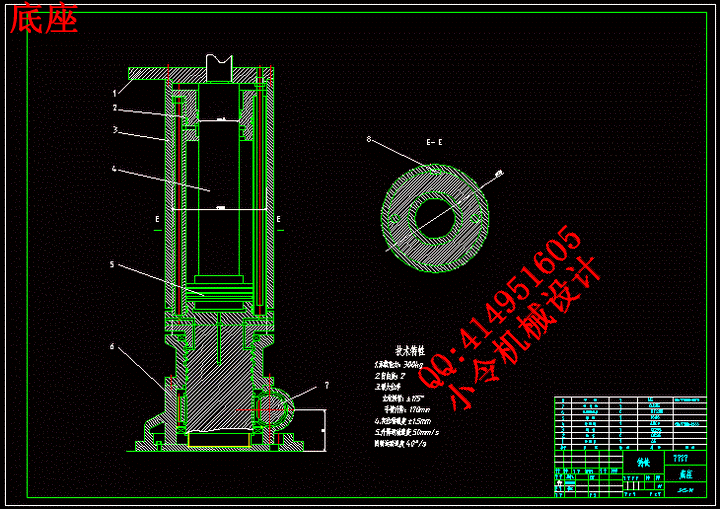【温馨提示】 购买原稿文件请充值后自助下载。
[全部文件] 那张截图中的文件为本资料所有内容,下载后即可获得。
预览截图请勿抄袭,原稿文件完整清晰,无水印,可编辑。
有疑问可以咨询QQ:414951605或1304139763










液压机械手是模仿人的手部动作,按照给定的程序、轨迹通过液压系统实现抓取和搬运操作的自动装置。
本次设计的液压传动机械手根据规定的动作顺序,综合运用所学的基本理论、基本知识和相关的机械设计专业知识,完成对机械手的设计,并绘制必要装配图、液压系统图、。机械手的机械结构采用油缸、螺杆、导向筒等机械器件组成;在液压传动机构中,机械手的手臂伸缩采用伸缩油缸,手腕回转采用回转油缸,立柱的转动采用齿条油缸,机械手的升降采用升降油缸,立柱的横移采用横向移动油缸;通过控制电磁阀的开关来控制机械手进行相应的动作循环,当按下连续停止按钮后,机械手在完成一个动作循环后停止运动。
本设计拟开发的上料机械手可在空间抓放物体,动作灵活多样,可代替人工在高温和危险的作业区进行作业,可抓取重量较大的工件。可以改善劳动条件,避免人身事故。可以减少人力,并便于有节奏的生产。
关键词: 机械手;液压;控制回路
Abstract
Hydraulic robot mimic is the hand movements which in accordance with a given program, the path through the hydraulic system to achieve automatic device to capture and handling operations.
The design of hydraulic drive manipulator movements under the provisions of the order , use the basic theory, basic knowledge and related mechanical design expertise comprehensively to complete the design,and drawing the necessary assembly, hydraulic system map, PLC control system diagram . Manipulator mechanical structure using tanks, screw ,guide tubes and other mechanical device component ;In the hydraulic drive bodies ,manipulator arm stretching using telescopic tank ,rotating column of tanks used rack ,manipulator movements using tank movements ,the column takes the horizontal movement of tanks ; through the control of the solenoid valve to control the switch manipulator corresponding moves cycle ,after press the row stop button , the manipulator complete a cycle of action to stop after the hole campaign.
The design of the proposed development of the information on the manipulator can grasp up in space objects ,flexible and varied movements ,can replace the artificial heat and dangerous operation conducted operations,and can grasp the larger work pieces . Can improve working conditions, avoid personal accident. Can reduce manpower, and to facilitate the there are-paced the production of.
Keywords: Manipulator ;Hydraulic;Control Loop
目 录
摘 要 III
Abstract IV
目 录 V
1 绪论 1
1.1 机械手的基本概念的研究内容和意义 1
1.1.1 机械手的基本概念 1
1.1.2 机械手的研究意义 1
1.2 机械手的发展现状及应用 1
1.2.1 世界机器人发展状况 1
1.2.2 我国工业机器人的发展 2
1.3 本课题达到的要求 2
2 液压机械手主要结构的机械设计 4
2.1 臂力的确定 4
2.2 确定工作范围 4
2.3 确定运动速度 4
2.4 手臂的配置形式 4
2.5 位置检测装置的选择 5
2.6 驱动与控制方式的选择 5
2.7 本章小结 5
3 手部结构 7
3.1 概述 7
3.2 设计时应考虑的几个问题 7
3.3 驱动力的计算 8
3.4 两支点回转式钳爪的定位误差的分析 9
3.5 本章小结 9
4 腕部的结构 11
4.1 概述 11
4.2 腕部的结构形式 11
4.3 手腕驱动力矩的计算 11
4.4 本章小结 13
5 臂部的结构 14
5.1 臂部概述 14
5.2 手臂直线运动机构 14
5.2.1 手臂伸缩运动 14
5.2.2 导向装置 15
5.2.3 手臂的升降运动 16
5.3 手臂回转运动 17
5.4 手臂的横向移动 17
5.5 臂部运动驱动力计算 17
5.5.1 臂水平伸缩运动驱动力的计算 17
5.5.2 臂垂直升降运动驱动力的计算 18
5.5.3 臂部回转运动驱动力矩的计算 18
6 液压系统的设计 20
6.1 液压系统简介 20
6.2 液压系统的组成 20
6.3 机械手液压系统的控制回路 20
6.3.1 压力控制回路 20
6.3.2 速度控制回路 21
6.3.3 方向控制回路 21
6.4 机械手的液压传动系统 21
6.4.1 上料机械手的动作顺序 21
6.4.2 自动上料机械手液压系统原理介绍 22
6.5 机械手液压系统的简单计算 24
6.6 双作用单杆活塞油缸 24
6.7 无杆活塞油缸(亦称齿条活塞油缸) 27
6.7.3 单叶片回转油缸 27
6.7.4 油泵的选择 28
6.7.5 确定油泵电动机功率N 29
7 结 论 30
致 谢 31
附 录 33
1 绪论
1.1 机械手的基本概念的研究内容和意义
1.1.1 机械手的基本概念
液压机械手,从本质上来说是属于工业机器人的范围的,机器人问题是最近几十年的热门研究课题。它包括了机械工程、计算机科学、电子工程和自动控制以及人工智能等多种学科,体现了机电一体化技术的最新成就,是当代科学技术发展最活跃的范围之一,也是我国科技界跟踪国际高技术发展的重要课题。
“机械手”(Machanical Hand):大部分是指附属于主机、程序固定的自动抓取、操作装置(我国一般称作机械手或专用机械手)。比如自动生产线、自动机的上下给料系统,加工中心自动化装置[1]。
1.1.2 机械手的研究意义
1.可以提高生产过程的自动化程度。
应用机械手有利于在自动生产线中实现材料的传送、工件的装卸、刀具的更换、以及机器的装配等的自动化程度,从而提高劳动生产率,降低生产成本。
2.可以改善劳动条件,避免人身事故。
3.可以减少人力,并便于有节奏的生产。
4.用液压系统来控制机械手,比一般的机械控制具有更好的稳定性,并且控制的精确度更高。
5.运用机械手可以实现连续的生产,而大大提高在生产线的工作的时间,从而能大幅提高劳动的生产率。
1.2 机械手的发展现状及应用
机械手的迅速发展是因为它的积极作用正逐渐被人们所认可;第一,它能部分代替体力人工操作;第二,它可以按照生产工艺的要求,按照一定的程序,时间和位置来完成工作的传送和装卸;第三,它能操作必要的器具进行焊接和装配。从而改善人们的劳动条件,显著的提高劳动生产率,加快实现工业生产机械化和自动化的步伐。因此,各先进工业国家都对此十分重视,投入大量的人力物力进行研究和应用。尤其在高温、高压、粉压、噪音以及带有放射性的污染的场合应用得更为广泛。在我国,近几年来也有较快的发展,并取得一定的效果,受到机械工业和铁路工业部门的重视[2]。
1.2.1 世界机器人发展状况
国外机器人领域发展近几年有如下几个趋势:
(1). 工业机器人性能不断提高(高速度、高精度、高可靠性、便于操作和维修),而单机价格不断下降。
(2).机械结构向模块化、可重构化发展。例如关节模块中的伺服电机、减速机、检测系统三位一体化;由关节模块、连杆模块用重组方式构造机器人整机;国外已有模块化装配机器人产品问市。
(3).工业机器人控制系统向基于PC机的开放型控制器方向发展,便于标准化、网络化;大大提高了系统的可靠性、易操作性和可维修性。
7 结 论
液压机械手是一种模仿人体上肢部分功能,按照预定要求输送工件或者握持工具进行操作的自动化技术设备,它可以代替手的繁重劳动,改善劳动条件,提高劳动生产率和自动化水平。有着广阔的发展前途。本课题通过机械手进行液压传动原理设计,实现机械手代替人力进行工作。设计中,在查阅大量相关文献的基础上,完成了以下工作:根据液压机械手的特殊性对其造型等方面的设计需求进行分析,从整体上把握其设计原则;然后对不同的功能区域进行单独的研究分析,总结出符合工程学要求的设计理论;最后将整体的设计分析和每一部分的设计相结合,寻找有效的结合点并进行统一协调,最终设计出高质量、高档次的产品。完成了对液压系统的各液压元件的设计、计算及选型。对液压机械手相关附件作了简要设计。液压机械手设计理论部分虽然完成了,但还需要进行实际的应用检验,并且找出其中的不足加以修改。
致 谢
本篇设计是在黄敏副教授和朱启兵副教授的指导下完成的,在此过程中,两位老师给予了我很多帮助。从课题的提出开始,两位老师就对我进行了无私的指导和帮助,不厌其烦的帮助进行论文的修改和改进。特别是在图纸设计的过程中,朱老师给了我很多很多指导,指出多处错误并不断帮助我修改。直到最后的定稿,老师还是多次查看,指导我规范格式。两位老师积极严谨的工作态度,让我在设计过程中少走很多弯路,使我能按时完成各步骤工作,最终完成毕业设计。
另外,我还要感谢我的班主任马老师,对我学习和生活上的关心。马老师总是能在我遇到困难的时候及时的给予我帮助。在写论文期间,马老师经常督促我们要每天都写论文,不要到最后赶工,直到最后几天看到许多同学都赶工,才知道马老师对我的的督促是对的。
当然,还要感谢我的同学们,感谢我的同学们在我又不懂的时候放下手头上的论文,来教我,让我感受到同学的友谊。
毕业在即,再感谢所有支持和帮助过我的领导、老师、同学们。
参考文献
张建民. 工业机器人[M]. 北京. 北京理工大学出版社, 1992.
天津大学《工业机械手设计基础》编写组. 工业机械手设计基础 [M]. 天津 天津科学技术出版社, 1981.
索罗门采夫. 工业机器人图册[M]. 北京. 机械工业出版社, 1993.
成大先. 机械设计图册[M]. 山东. 化学工业出版社, 2002.
金茂箐. 我国工业机器人发展现状[J]. 机器人技术与应用, 2001(4)24~28.
王田苗. 工业机器人发展思考[J]. 机器人技术与应用, 2004(2):23~25.
杰克. 机械与机构的设计原理[M]. 北京.机械工业出版社, 1985.
王玉新. 机构创新设计方法学[M]. 天津.天津大学出版社, 1996.
邓星钟. 机电传动控制[M]. 武汉.华中科技大学出版社, 2002.
马香峰. 机器人结构学[M] . 北京.机械工业出版社, 1991.
李瑞峰.21世纪--中国工业机器人的快速发展时代[J]. 中国科技成果, 2001(18):34~38.
乔东凯 黄崇林. 移动式工业机器人设计的动力学分析[J]. 茂名学院学报, 2003(3):65~76.
B. Riveiro, An innovative method for remote measurement of minimum vertical underclearance in routine bridge inspection[J], ELSEVIER, 2012(25): 34-40.
Dhananjay E. Upasani, Development of Remote Control System for Bridge Inspection Using Robot and Digital Image Processing Technology[J], International Journal of Computer Applications, 2010(1): 18.
Structures Evaluation Services Bureau, Special Issue on Nondestructive Evaluation and Testing for Bridge Inspection and Evaluation, 2012(17): 827-828.
Bedford A, Fowler W. Engineering Mechanics: Vol 2: Dynamics[M]. New York : Addison Wesley Publishing Company Inc, 2006(8):10.
 川公网安备: 51019002004831号
川公网安备: 51019002004831号